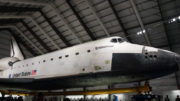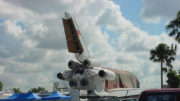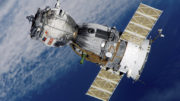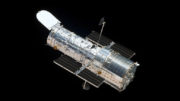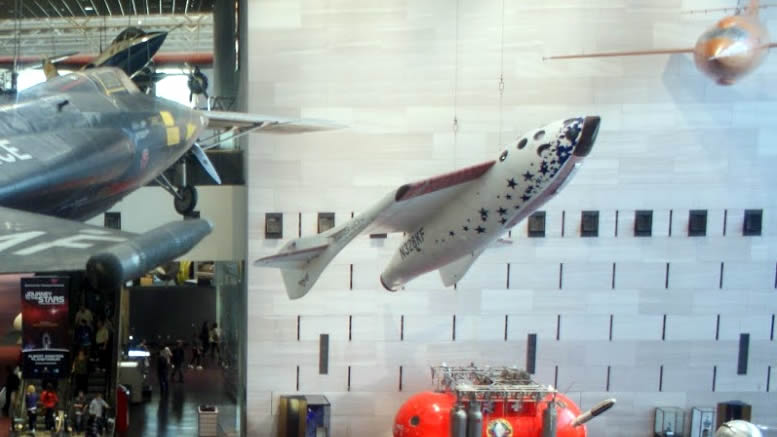 A privately-developed rocket plane launched into history on June 21 2004 on a mission to become the world’s first commercial manned space vehicle.
A privately-developed rocket plane launched into history on June 21 2004 on a mission to become the world’s first commercial manned space vehicle.
SpaceShipOne rocketed 100 kilometers (62 miles) into sub-orbital space above the Mojave Civilian Aerospace Test Center, a commercial airport in the California desert.
Sub-orbital space flight refers to a mission that flies out of the atmosphere but does not reach the speeds needed to sustain continuous orbiting of the earth. The view from a sub-orbital flight is similar to being in orbit, but the cost and risks are far less.
The pilot, 62-year-old Scaled Composites vice-president Mike Melvill became the first person to earn astronaut wings in a non-government sponsored vehicle.
“Since Yuri Gagarin and Al Shepard’s epic flights in 1961, all space missions have been flown only under large, expensive Government efforts. By contrast, our program involves a few, dedicated individuals who are focused entirely on making spaceflight affordable,” said Burt Rutan. “Without the entrepreneur approach, space access would continue to be out of reach for ordinary citizens. The SpaceShipOne flights will change all that and encourage others to usher in a new, low-cost era in space travel.”
SpaceShipOne was designed by Rutan and his research team at the California-based aerospace company, Scaled Composites. Rutan made aviation news in 1986 by developing the Voyager, the only aircraft to fly non-stop around the world without refueling.
To reach space, a carrier aircraft, the White Knight, lifts SpaceShipOne from the runway. An hour later, after climbing to approximately 50,000 feet altitude just east of Mojave, the White Knight releases the spaceship into a glide. The spaceship pilot then fires his rocket motor for about 80 seconds, reaching Mach 3 in a vertical climb. During the pull-up and climb, the pilot encounters G-forces three to four times the gravity of the earth.
SpaceShipOne then coasts up to its goal height of 100 km (62 miles) before falling back to earth. The pilot experiences a weightless environment for more than three minutes and, like orbital space travelers, sees the black sky and the thin blue atmospheric line on the horizon. The pilot (actually a new astronaut!) then configures the craft’s wing and tail into a high-drag configuration. This provides a “care-free” atmospheric entry by slowing the spaceship in the upper atmosphere and automatically aligning it along the flight path. Upon re-entry, the pilot reconfigures the ship back to a normal glider, and then spends 15 to 20 minutes gliding back to earth, touching down like an airplane on the same runway from which he took off. The June flight will be flown solo, but SpaceShipOne is equipped with three seats and is designed for missions that include pilot and two passengers.
Unlike any previous manned space mission, the June flight will allow the public to view, up close, the takeoff and landing as well as the overhead rocket boost to space. This will be an historic and unique spectator opportunity. Based on the success of the June space flight attempt, SpaceShipOne later won the Ansari X Prize, an international competition to create a reusable aircraft that can launch three passengers into sub-orbital space, return them safely home, then repeat the launch within two weeks with the same vehicle. Under the command of test pilot Mike Melvill, SpaceShipOne reached a record breaking altitude of 328,491 feet (approximately 62 miles or 100 km), making Melvill the first civilian to fly a spaceship out of the atmosphere and the first private pilot to earn astronaut wings.
This flight begins an exciting new era in space travel,” said Paul G. Allen, sole sponsor in the SpaceShipOne program. “Burt Rutan and his team at Scaled Composites are part of a new generation of explorers who are sparking the imagination of a huge number of people worldwide and ushering in the birth of a new industry of privately funded manned space flight.”
A large crowd watched the momentous flight live from the grounds of the Mojave Airport, joining millions of others around the world who tuned in by television, radio, and the internet. Dignitaries attending the event included U.S. Representative Dana Rohrabacher, the Commanding Officer of Edwards Air Force Base, General Pearson and the China Lake Naval Air Warfare Center, Admiral Venlet; former astronaut Buzz Aldrin, and Konrad Dannenberg, one of Werner Von Braun’s lead scientists on this country’s original space development effort. Hundreds of media representatives were also on hand to record history in the making.
Following 17 flights of SpaceShipOne the craft was retired to the Smithsonian National Air and Space Museum in Washington DC in October 2005 (Picture above). During its brief career SpaceShipOne achieved a number of firsts like being the first privately built craft to go supersonic. The lessons learned from its success as a reusable spacecraft led to the development of SpaceShipTwo.

